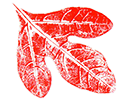The carpenter mimic leafcutter bee (Megachile xylocopoides) can be found throughout most of the eastern U.S., although some of the sources I found seem to suggest that it might be more common in the southern portion of its range than the northern portion. NatureServe ranks this species as “apparently secure” to “secure,” meaning that its population appears to be stable.
Most of the time I don’t worry about identifying native bees to species. The physical differences between different species can sometimes be so minute that you have to have look at the bee under a microscope to identify it to species. For my purposes of just enjoying and appreciating all the different types of bees that visit my garden, I don’t necessarily need to know the species. Usually, I’m perfectly happy to identify it to a general group of bees (bumble bees, sweat bees, etc.) and know that it could be one of many species in that group. However, there are a few native bees that I’m comfortable identifying to species. The carpenter mimic leafcutter bee is one of those species.

The reason I feel confident in identifying the carpenter mimic leafcutter bee to species is because it looks so different from our other native bees. The carpenter mimic leafcutter bee is one of our larger bees. It isn’t quite as large as a carpenter bee, but it is obviously larger than a honey bee and has a distinctive, big, bulky appearance. The fact that it is jet black and shiny, or mostly shiny, makes it even more eye-catching. The females have few if any hairs on the upper part of their body, while the males have some whitish hairs on their heads and thoraxes.
Carpenter mimic leafcutter bees get their common name because they supposedly resemble carpenter bees which have shiny abdomens. Even the carpenter mimic leafcutter bee’s scientific name refers to this resemblance. Megachile is the genus of leafcutter bees and xylocopoides means like Xylocopa – the genus of the large carpenter bees that we are all so familiar with. I see the resemblance, but to me the carpenter mimic leafcutter bee looks more like a body builder or maybe the model for a comic-book super hero.
Like other leafcutter bees, the carpenter mimic leafcutter bee is a solitary bee meaning that each female builds and provisions her own nesting chamber before laying her own eggs in the chamber. A key identifying factor of all members of the leafcutter bee family is that the females gather pollen under their abdomens to carry back to their nesting chambers. This is different than many other bees, including the honey bee, which carry pollen on their legs. Members of the leafcutter bee family are the only bees known to carry pollen under their abdomens.
According to Bugguide.net, the carpenter mimic leafcutter bee is an Asteraceae pollen specialist. In other words, the females only gather pollen from flowers in the Asteraceae family which includes plants like asters, sunflowers, goldenrods, ironweeds, daisies, coneflowers, etc. I see carpenter mimic leafcutter bees most often when they are gathering pollen from the cup plant flowers, a close cousin of sunflowers, in my garden.
Like most other native bees, we really don’t know much about this specific species. Most of what we know is true (or generally true) for all (or most) species in this genus or family. The carpenter mimic leafcutter bee is actually in an elite group of native bees because it has a common name. Most native bees only have scientific names. Part of the reason is because so many of them are so hard to identify in the field, and part of the reason is because we know so little about the individual species. I’ve said it before, and I’ll say it again, but this is just another example of all the things we don’t know about so many of the animals that live right outside our doors.

This article was part of Shannon’s original Kentucky Pollinators and Backyard Wildlife blog which evolved into the blog for Backyard Ecology.

Backyard Ecology: Exploring Nature in Your Backyard
Nature isn’t just “out there.” It’s all around us, including right outside our doors. Hi, my name is Shannon Trimboli, and I am the host of Backyard Ecology. I live in southcentral Kentucky and am a wildlife biologist, educator, author, beekeeper, and owner of a nursery specializing in plants for pollinators and wildlife conservation. I invite you to join me as we ignite our curiosity and natural wonder, explore our yards and communities, and improve our local pollinator and wildlife habitat. Learn more or subscribe to my email list at www.backyardecology.net.

Leave a Reply to Linda Watson Cancel reply